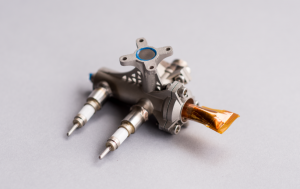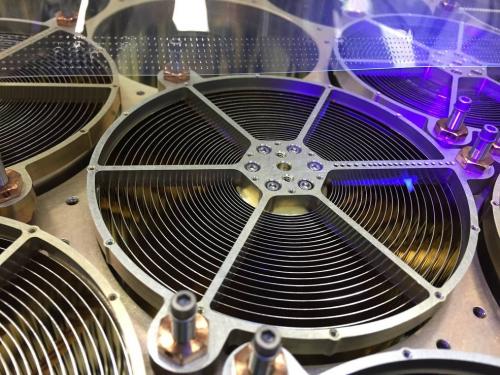Goddard X-Ray Technology Opens New Frontiers In Space And Here On Earth
Time and time again, the path of basic research takes surprising twists and turns.

This miniaturized X-ray source can be modulated in intensity from completely off to full intensity, over 100 keV, in subnanosecond timescales. The high speed switching capability and miniature size make possible many new technologies including X-ray-based communication, compact time resolved X-ray diffraction, novel X-ray fluorescence instruments, low precise dose medical X-rays and more.
“Why does NASA spend money on technologies to look at black holes when there are so many things on Earth we need to fix?” asked Keith Gendreau, an astrophysicist at NASA’s Goddard Space Flight Center in Greenbelt, Maryland. “It turns out that the work we do here impacts people in tangible ways.”

NICER’s X-ray concentrator optics are inspected under a black light for dust and foreign object debris that could impair functionality once in space. The payload’s 56 mirror assemblies concentrate X-rays onto silicon detectors to gather data that will probe the interior makeup of neutron stars, including those that appear to flash regularly, called pulsars.
A tiny technology Gendreau developed to study black holes now has potential as part of a life-saving medical device, thanks to this process of curiosity and discovery. The Miniaturized High-Speed Modulated X-ray Source (MXS) has a diverse array of possible applications stretching far beyond the realm of astrophysics.
Each year, the NASA Inventions and Contributions Board recognizes a technology that has contributed significantly to NASA programs. The board chose MXS as NASA’s 2019 Government Invention of the Year, the first time Goddard has received this recognition since 2002. With its multifaceted uses in medical imaging, materials science, space communication and more, MXS serves as a reminder that NASA’s exploration of space can result in tangible benefits for people on Earth.
From Black Holes to CT Scanners
MXS was created to help us peer into the universe with sharp X-ray eyes. In his role as an astrophysicist, Gendreau envisioned a highly advanced imager that could capture pictures of a black hole’s event horizon. The design of this telescope required an X-ray beacon, so Gendreau developed an X-ray source that could vary the intensity of its output rapidly, brightening and dimming at pre-determined intervals.
“When you go after challenging goals, the technologies required to achieve those goals are even more challenging,” Gendreau said. “This often means that you open more doors than you originally intended.”
Already, MXS has opened multiple doors. The technology played an important role in testing of NASA’s Neutron star Interior Composition Explorer (NICER)/Station Explorer for X-ray Timing and Navigation Technology (SEXTANT) mission, an external payload on the International Space Station.
Before NICER’s launch in 2017, MXS calibrated the mission’s X-ray detectors, ensuring they could make accurate observations of black holes and other X-ray emitting celestial objects. MXS provided both an energy reference and a timing reference, offering unmatched nanosecond-level precision.
“Because the mission's goals are to capture and understand the fast flickers, flashes and pulses in X-rays that are emitted by black holes, neutron stars and other energetic objects in the universe, having MXS to simulate those behaviors during ground testing was invaluable," said Zaven Arzoumanian, a Goddard astrophysicist and co-inventor of MXS.
Gendreau and Arzoumanian, along with Goddard co-inventors Steven Kenyon and Nick Salvatore Spartana, knew this application was just one of many for the versatile invention.
“Sometimes, basic research can touch people’s lives in ways that you don’t immediately know or can’t predict,” Gendreau said.
For example, the NASA researchers and partners at Massachusetts General Hospital and the Massachusetts Institute of Technology (MIT) have demonstrated an innovative computed tomography (CT) scanner for medical imaging with MXS. CT systems generate 3D images of internal organs by using X-rays to scan the body in cross sections. Computer software stitches the cross sections together to create a highly detailed image, used by medical professionals to screen for tumors, analyze bone fractures, search for blood clots in lungs or examine brain injuries.
A MIT-led 2018 paper in the journal Scientific Reports describes the novel technology — a portable, no-moving-parts imaging system that offers fine-tuning of the radiation dose received by a patient — and laboratory testing, which generated a detailed 3D image of a pig lung at a quality competitive with current CT scanners. The increased mobility and lower dose of radiation offered by an MXS-based device could result in better and safer access to medical care in rural areas and low-income countries. For future space travel, astronauts could bring a portable CT scanner for medical care on long-distance journeys, such as to Mars.
Under NASA’s Space Act Agreement with Massachusetts General Hospital, researchers continue to study the innovation for practical use.
Wider Reach with Technology Transfer
Massachusetts General Hospital isn’t the only organization interested in MXS. Through technology transfer, companies can license MXS from NASA and apply the invention toward a commercial product. With applications in many industries, MXS is full of potential in the private sector.
The device possesses two advantages over prior state-of-the-art X-ray sources. First, it is small and lightweight — about the same size as a deck of cards. Second, MXS is less fragile than traditional X-ray sources and requires less maintenance. The improvements in size, weight, and robustness increase the technology’s flexibility and portability, creating opportunities for new applications not previously possible.
While several companies are considering MXS for licensing agreements, chemists at Washington State University have incorporated MXS into an ion mobility spectrometer, which can detect chemical agents, including potentially dangerous substances, in the air. Gendreau said it could increase the sensitivity of the device, and since MXS produces X-rays electronically instead of radioactively, it is subject to fewer regulations.
Abundant applications of MXS continue to unfurl in other areas, such as deep space communications. Known as XCOM, this new form of sending information could achieve better power efficiency than radio or laser systems in the vacuum of space, since X-rays have shorter wavelengths.
With its roots as a technology for black hole imaging, MXS has blossomed into a practical innovation with many divergent applications. Its tendrils extend to unforeseen areas of purpose, growing ever more versatile as time passes.
“I’m sure there are other functions for MXS that we don’t know about yet, waiting to be discovered,” Gendreau said.
Source: U.S. National Aeronautics and Space Administration
- 217 reads
Human Rights
Ringing FOWPAL’s Peace Bell for the World:Nobel Peace Prize Laureates’ Visions and Actions

Protecting the World’s Cultural Diversity for a Sustainable Future

The Peace Bell Resonates at the 27th Eurasian Economic Summit

Declaration of World Day of the Power of Hope Endorsed by People in 158 Nations

Puppet Show I International Friendship Day 2020

